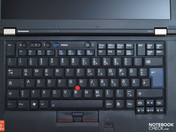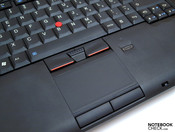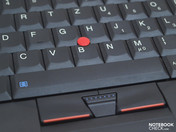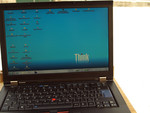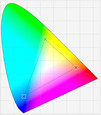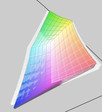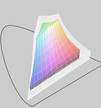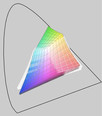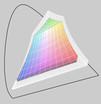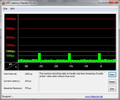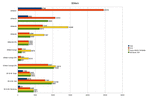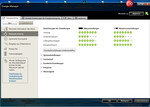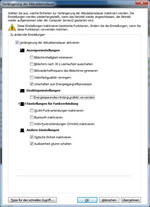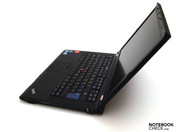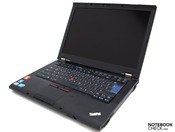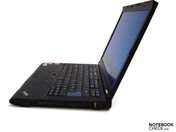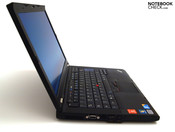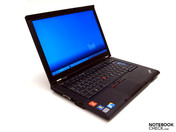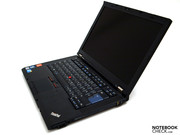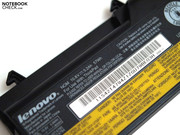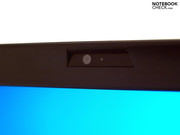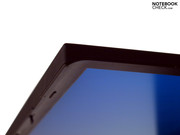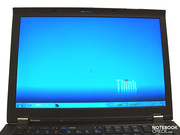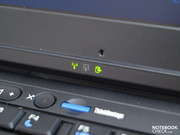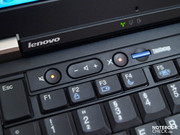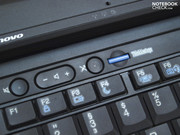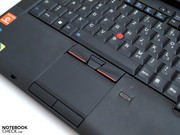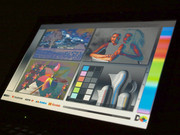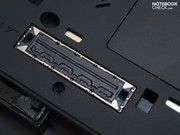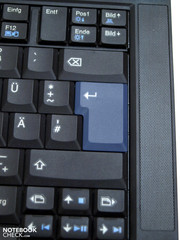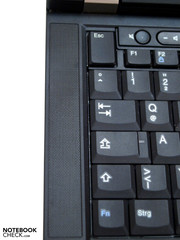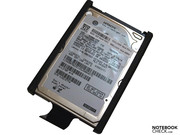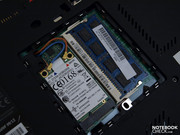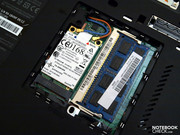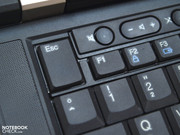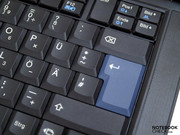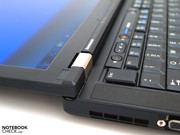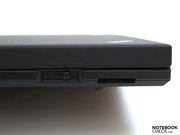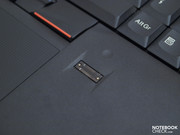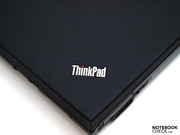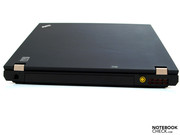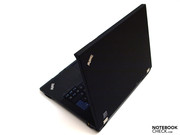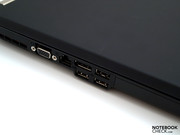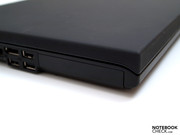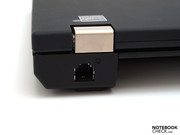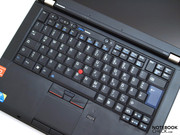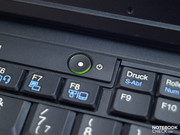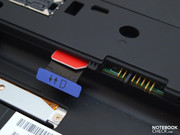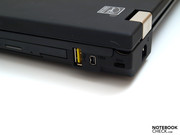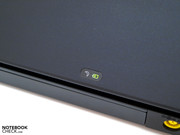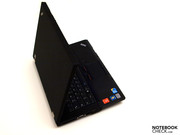Review Lenovo Thinkpad T410 2522-3FG Notebook
Just an illusion?
Lenovo updates its T-range's 14.1 inch models to state-of-the-art with the Arrandale CPUs. The validated Thinkpad design and the qualities attached to it haven't been compromised on. Our prototype is equipped with a Core i7 620M CPU, a dedicated NVIDIA NVS 3100M graphic card and a 4 GB DDR3 RAM. Can the graphics be switched for energy saving reasons like in the T400 top models? We'll answer this question in the run of our comprehensive test course, as well.
The T-range contains efficient laptops aligned for mobile business use, and can be classified between the R-range laptops and the more efficient mobile W-range workstations in terms of performance. You'll find Thinkpad experts in the X-range for an ultra mobile use. Aside from that, the inexpensive SL-range and the Edge range laptops for small businesses belong to Lenovo's business products
Currently, four T-ranges are available. The T400 (14.1 inch) and the T500 ranges (15.4 inch) have already been on the market for a while and still use seasoned hardware components. You could say the T410 range and the T510 range, now equipped with Arrandale processors, represent the latest upgraded versions.
A few T410 models only have one integrated Intel GMA HD graphic chip. Then again, others use the possibility of a dedicated Nvidia NVS 3100M graphic card. Interestingly, the device is already offered in various shops in Europe although you still have to wait for the official manufacturer data in Germany. Therefore, we will fall back on information from the US site, on the data sheets that we received directly from Lenovo on inquiry and information from various internet sites.
Case
The case reminds of the already reviewed Lenovo T400. Apart from the typical Thinkpad design components - the blue return key, red trackpoint, the according logos and not to forget the blue "ThinkVantage" button, the silver hinges and various inevitable stickers - it has been made completely in a matt black. In terms of size, it equals its T400 predecessor measuring 335 millimeters width, 239 millimeters depth and 31.9 millimeters height.
Even if both look alike at first sight, there are significant differences in regards to connectivity and distribution. However, it has the weaknesses in the Ultra Bay slot area and the plastic covers above the keyboard, already known from the T400. The case can yield and creak somewhat under selective pressure here. Basically, you can be satisfied with the base unit's stability, anyway. The display components have a good torsional stiffness and pressure resistance, even if the display lid unlikely will reach the T400's qualities. It twists a bit when it's picked up at a corner and image distortions turn up on the enabled screen, as well. The hinges yield first before image changes can evolve under selective pressure. Image falsifications can also be noticed by moderate retention and medium pressure. Additionally, the display bezel yields considerably under pressure, whereas image deviations also become visible.
The hinges barely teeter after adjusting the opening angle, but they surprisingly don't manage well in an instable work environment (train journey). A single-handed opening and closing is possible because they run smoothly. Moreover, the maximum opening angle of even a bit more than 180 degrees won't cause any restrictions.
A double hook closure system and the known clamshell design offer protection against foreign objects unintentionally penetrating the gap between keyboard and display. The opening mechanism is easy to operate, but creaks a bit. Lenovo has made improvements in terms of maintainability. Now a RAM module and the GOBI2000 card (broad band modem) can be accessed, aside from the hard disk.
Connectivity
Lenovo has kept all important, and for a laptop of the business category, necessary ports in mind. There is a docking port on the bottom, over which you not only can easily connect the 14.1 incher into an already existent work environment, but also extend the interface-allocation.
Currently, there are 4 different docking stations available in the United States. However, one of them is connected via USB. Therefore, only three options are left for using the docking port: First, the ThinkPad Port Replicator Series 3 for around 149 US dollars, second the ThinkPad Mini Dock Series 3 (US/Canada/LA) with 6 USB 2.0 ports, VGA, DVI, DisplayPort (2 video interfaces can be used simultaneously) and an analog headphone and microphone socket for about 199 US dollars. And the third option is the ThinkPad Mini Dock Plus Series 3 (US/Canada/LA) with an additional DVI and display port, RJ-45 and eSATA connection for around 229 US dollars. You can practically ban all cables that might restrict the work space on the notebook's sides to the back with the latter.
Four USB 2.0 ports, three of which are almost on the left's center and one is almost on the far back right, are directly on the notebook. External monitors or projectors can be connected analogly via VGA. Additionally, Lenovo has also kept a digital display port in mind, with which also high resolutions in a good quality should be possible on external monitors. The functionality can be extended via ExpressCard/34 modules. The correlating slot is on the right front area. An eSATA connection and an combo audio socket are also found on the front area.
Aside from the already mentioned USB ports, the right side also accommodates an Ultrabay slot, which is standardly equipped with a DVD burner (alternative equipment is optionally available), a FireWire connection and a Kensington Security slot. There is only a RJ-11 modem interface on the back beside the DC-in. The front completes the connectivity with a 5-in-1 cardreader, which usually supports following formats: MS, MS Pro, SD, SM, MMC.
The interface distribution isn't perfect for neither lefties nor for righties. All connections on the left are practically in the center area. Also, the three USB ports and the display port, in a block of four, are so close to each other and by the LAN connection that you have to use narrow USB plugs. It looks better on the right as long as you aren't intending to use any eSATA devices. The combo audio socket has also been placed on the right, pretty much in the front. The main control for the WiFi modules, also here, has been positioned on the beveled edge so that the slider position can't be seen at all without wrenching. Aside from that, the slider is only suitable for persons with thin fingers.
Lenovo has practically put all useful and available communication features into the Thinkpad T410. You can exchange data wirelessly with small external mobile devices, for example a cell phone or PDA, over Bluetooth 2.1. A GOBI 2000 from Qualcomm is available as a broad band modem. A SIM card from Vodafone is also included right away. Fast connections via WiFi hotspots with the built in Intel Centrino Ultimate-N 6300 AGN (agn) are even possible with n-standard support if necessary. Other configurations are dependent on the model.
For cabled use, there is an Intel 82577LM gigabit network connection (10MBit) for Ethernet connections available on the one hand, as well as a RJ-11 modem connection that could make an internet connection via a telephone cable possible in areas with a sparse infrastructure on the other. So, basically internet telephony and electronic mail with business partners shouldn't be a problem. Even video telephony via internet is possible without further ado due to the built-in 2.0 MP webcam.
Windows 7 Professional 64bit was preinstalled on our prototype. Optionally, Windows 7 Ultimate can also be selected. Both Windows 7 versions are also available as a 32 bit option. A 32 bit operating system doesn't seem sensible in our prototype already in view of the memory size of 4 gigabytes - unless there are only 32 bit drivers for existing peripheral devices available.
Lenovo has made a few modifications in Windows 7 and has tried to optimize Windows 7 with that. The Lenovo Enhanced Experience Technology is supposed to make a faster booting and shut down possible. This statement is made by the manufacturer and hasn't been checked.
Lenovo has been stingy in terms of supplies. Only a few sheets of paper are in the box along with short instructions. Operating system media, recovery DVDs, driver media or even Windows 7 installation media is looked for in vain, though. In return, you can easily create recovery DVDs with Lenovo's ThinkVantage tool. This tool also supports a recovery from a hidden partition. If you press the "ThinkVantage" button just at the right moment during booting, you are shown a menu with various options. If you choose F11 "to diagnose hardware or recover your system" you get the message "Press <F1> to Setup" after two beeps, which you can exit with ESC. Afterwards, the "ThinkVantage Rescue and Recovery" tool is started and you can restore the factory preinstalled hard disk content, among other things.
The Thinkpad T410's security features include a Kensington Security slot, a splash water protected keyboard and a fingerprint reader that has to be configured with the ThinkVantage tool before use. The built-in hard disk also supports hardware encryption. A SmartCard reader is optionally available.
The basic warranty period only includes 1 year bring-in service in the USA. Various warranty extensions can be purchased. A 3 year onsite service (Priority) costs around 279 US dollars. In Europe the warranty period of T-series models is 3 years by default.
Input Devices
Keyboard
The splash water protected keyboard doesn't look much different to that of the T400 at first sight. The tested and tried IBM keyboard has once again been used. Apart from the Crtl and FN key being in the opposite order, the layout complies with the usual standard, whereas the keys have been clearly grouped. A difference to the T400 is only found in the design of the upper two rows: The ESC key is longer and the F keys had to be moved a bit to the right, in return. The INS key had to leave the group with the DEL key. The latter has been stretched just like the ESC key. Thus, there is hope that you'll not hit INS instead of DEL as quickly and unintentionally change to the insert mode in word processing.
The hotkey bar has also been redesigned. Now there is a separate button for controlling the microphone. Additionally, you can mute, adjust the volume (now with a rocker switch) and address the ThinkVantage tools. The keyboard light has its place in the upper display bezel again and can be controlled with FN+PAGE-UP.
As usual there's nothing to complain about in terms of the keyboard's mechanical traits. Concave key surfaces add to the typing comfort. Unfortunately, the keyboard is quite loud especially at vigorous typing, in particular the space key. But touch typing is a delight right from the start.
Touchpad
The touchpad and trackpoint can be enabled or disabled independently with FN-F8. The touchpad has, regrettably, been renewed. It now supports a few multi-touch gestures and you can scroll with its assistance and with the optically and haptically marked scroll fields alike. But the mouse cursor control isn't perfect any longer. The multi-touch features are frequently triggered unintentionally.
The touchpad's surface has also been given a facelift. The surface is now slightly knobby and feels a bit grainy. The gliding traits are alright, though. The touchpad barely delimits itself from the surrounding case by a simple component seam. The touchpad buttons are found on the beveled edge. They are smooth, respond well on their entire width and don't make a loud click noise, either.
Alternately, the red trackpoint can be used. It allows a very precise mouse cursor control. Unfortunately, the correlating buttons are somewhat louder and click audibly, but the functionality doesn't give reason for complaint.
Display
A matt 14.1 inch sized WXGA+ TFT with LED backlight is used in our Lenovo T410. This results in a resolution of 1440x900 in a 16:10 format. Although it's also a wide screen format the height isn't quite as limited as in the new 16:9 formats. Lenovo has obviously considered that vertical orientated applications are used more frequently in office use. Even if the 16:10 still can't quite compete with the almost no longer used 4:3 format in this regard.
| |||||||||||||||||||||||||
Brightness Distribution: 79 %
Contrast: 136:1 (Black: 1.37 cd/m²)
The display wasn't really convincing in terms of measuring data. Its measured rates are on about the same level as the reviewed T400. The average brightness is about equal. In return, the maximum brightness is lower and this leads to a better illumination of an almost good 79%. Then again, the black value of 1.37 cd/m2 turns out fairly high, whereas the maximum contrast of 136:1 remains average.
Control measurements with our Spyder 3 Elite colorimeter show that the T410 has a rather weak, small color space, with which it is on about the same level as the old r50ps (German review) or the Macbook Whites. It is definitely defeated by the current Wide Color Gamut displays and, of course, Full RGB displays. In following, a few visualizations of the executed measurements. The correlating transparent comparison color space is marked with a (t). We were particularly interested in how the bigger T510 model with a 15 inch FHD (1920x1080) with 280 nit and 95% color gamut (manufacturer statement) will manage in this regard.
The T410 doesn't vary from the reviewed T400 in terms of viewing angles and thus not really from the majority of the laptop competition. The horizontal plane can be described as granting a big work field, while slight deviations from the ideal, perpendicular viewing angle already leads to image distortions in the form of dimming or over-illumination on the vertical plane.
Performance
In regards to the components responsible for performance inside, Lenovo has a few alternatives for the T410. Therefore, you should closely look at which components are really built-in. In any case, the laptop uses one of the new Core i processors that are manufactured under the code name "Arrandale". The options range from an Intel Core i5-520M (240GHz, 3 MB L3, 1066MHz FSB) as the least efficient alternative, over Intel's Core i5-540M (2.53GHz, 3MB L3, 1066MHz FSB) up to Intel's Core i7-620M CPU (2.66GHz, 4MB L3, 1066MHz FSB). Additionally, some models with only an integrated GMA HD graphic chip and others with a dedicated Nvidia NVS 3100M graphic card are offered. Main memory configurations of two to four gigabytes are available ex-factory.
Our test device correlates with the current top model of the T410 range based on Intel's ID044 chip set and has an Intel Core i7-620M processor, Nvidia's Quadro NVS 3100M graphic card and a 4 GB DDR3 (PC3-8500F; 533MHz) RAM. The Nvidia Quadro NVS 3100M is a DirectX 10.1 suitable business graphic card that is based on the GT218 core (GeForce 210M) and therefore only supplies starter performance. The drivers are specialized for business applications and should provide a maximum compatibility and stability. It supports decoding HD videos (H.264, VC-1, MPEG-2, MPEG-4 ASP) with PureVideo HD (VP4). CUDA and DirectX Compute accelerate video decoding for example.
Nevertheless, the Quadro NVS 3100M's 3D performance stays in the starter field. A considerably better graphic performance can be expected in comparison to models with an integrated GMA HD graphic chip, anyway. Generally, you can expect a solid and stable and good office performance, though. If our expectations can be lived up to can be seen right away, when we look at the benchmarks.
To exclude problems caused by too long latencies when external devices are connected, we checked them with the DPC Latency Checker and can give the go-ahead here. The latencies always stay within a green field. You should test the external device in mind, i.e. an external sound card, beforehand in the notebook to make sure that it really works with the T410 without complaint.
| PCMark Vantage Result | 5575 points | |
Help | ||
Of course, we wanted to find out which innovations the T410 brings along in comparison to its predecessor, the T400. To be fair, we should mention that the T400, with an Intel Core 2 Duo P8600 2.4 GHz, integrated Intel GMA 4500M HD graphic chip and only a two gigabyte RAM, reviewed by us a while ago wasn't the top model of the T400 range at the test time. A comparison with the T400 top model would definitely have been more interesting and much fairer.
Unsurprisingly, the PCMark Vantage rates turn out much better than in the predecessor, the T400 prototype. The T410's overall rate outdoes the T400 by almost 160%. Details are evident in the chart.
In order to also be able to compare the new Thinkpad T410 with more current hardware, we used a device with a Core i7-720QM Clarksfield CPU, the Dell Studio 1557, which competes with an ATI Mobility Radeon HD 4570, a four GB RAM and a 7200 rpm hard disk with 320GB. The Studio's total rating is slightly poorer but scores especially with a better gaming rate and in the productivity score. In return, the Thinkpad T410 can boast with a better rate in the hard disk performance and communication.
| 3DMark 03 Standard | 10700 points | |
| 3DMark 05 Standard | 6783 points | |
| 3DMark 06 Standard Score | 3294 points | |
| 3DMark Vantage P Result | 1101 points | |
Help | ||
As expected, the T410 can also serve with a better performance in terms of hard disk performance in comparison to its forerunner. The Hitachi HTS725025A9A with a gross capacity of 250 GB built into the prototype works with 7200 rpm. It belongs to the Travelstar 7K500 family and is described in detail on Hitachi's homepage. The rates are majorly in the center span of comparable hard disks and the access rate of 16.7 ms also turns out reasonable for this hard disk category.
There are a few differences depending on the model in this case, too. The following options are offered: 80 / 128GB SSD, 160GB (5400 rpm / 250GB (5400 / 7200 rpm) / 320GB, (5400 / 7200 rpm) / 500GB (7200 rpm) HDD. A HL-DT-ST DVDRAM GU10N has been built-in as an optical memory unit in our prototype.
Computer games are definitely not the most important application field of a business device. But they reflect the 3D performance capabilities of a computer system well and therefore belong to our test course for all, in terms of graphics, halfway efficient systems. One thing first: The Nvidia Quadro NVS 3100M arranges itself in our performance class 3, which represents the lower middle class. Therefore, we aren't expecting any very big leaps. The drivers have also been optimized for business applications, which mean they have been aligned for maximum compatibility and stability and not for gaming performance.
We'll first take a look at the synthetic benchmarks. Just as unsurprisingly, our prototype manages to leave the reviewed predecessor model behind in all 3DMark tests. Now again, a comparison with Dell's Studio 1557: Depending on the benchmark, either the Studio 1557 or the Thinkpad T410 has the lead. Whereas the Studio 1557 can score in the CPU-biased ratings, e.g. + 19% in 3DMark Vantage CPU rating and +25% in Cinebench multi-rendering. In return, the Lenovo achieves +24% in 3DMark03, +14% in 3DMark05 and +6% in 3DMark Vantage. Systems with a stronger graphic card, such as the Aspire 8940G, leave both far behind. Detailed rates are evident in the chart.
As expected, the performance is only sufficient for demanding games in minimum details and low resolutions.
It was enough for 58fps in Anno 1404 (2009) in a resolution of 1024x768, low presettings and disabled vsync. It's only still 12 fps when the requirements are increased to a resolution of 1280x1024 pixels, very high presettings and disabled vsync.
We also receive a similar picture for Crysis in a resolution of 1024x768 pixels. The game internal CPU and GPU benchmarks only indicate 56 fps (GPU) and 50 fps (CPU) in low settings, 19 fps for both in medium and merely 10 fps (GPU) in high settings. The CPU benchmark doesn't even run through completely in high settings. Therefore, a smooth game enjoyment is only possible in low settings.
It looks better with older and less demanding games. We selected Call of Duty 4 for our test and can confirm that it still achieves a playable 42 fps in high details - that is a resolution of 1280x1024 pixels, 4xAA and settings enabled and high. We'd like to refer to our gaming list and our graphic card benchmarks for further information.
no benchmarks found
Emissions
System Noise
Subjectively, the fan noise is always existent, but also always still well acceptable. This is also confirmed with our assessed rates. We record a maximum of 37.8 dB(A) under load. Therewith, a very audible, but not particularly loud rate is reached. It's 34.4 dB(A) on average under load. The volume only turns out slightly lower with a consistent 33.3 dB(A) under low load. The system noise at DVD rendering equally remains within a limit.
Noise level
| Idle |
| 33.3 / 33.3 / 33.3 dB(A) |
| HDD |
| 33.9 dB(A) |
| DVD |
| 35.4 / dB(A) |
| Load |
| 34.4 / 37.8 dB(A) |
 | ||
30 dB silent 40 dB(A) audible 50 dB(A) loud |
||
min: | ||
Temperature
The Lenovo Thinkpad T410, in its tested configuration, can get quite warm under load. This applies especially to the bottom, which makes a use on the lap not very recommendable with a maximum of 44.6 degrees Celsius and a generally warmer fan area (over 40 degrees Celsius) in 3D-biased applications. The 40 degree mark is also slightly surpassed in the central upper side area; that is exactly in the keyboard's center. In return, the touchpad and wrist-rest always stay pleasantly cool.
If the impression has turned up that the device tends to overheat, we can give the all-clear. The inner component's temperature stayed within limits even after a 12 hour stress test. A 3DMark test executed immediately afterwards confirmed that there are only insignificant deviations in the result. In short: No throttling due to too low cooling performance!
Besides, a perpetual full capacity use won't belong to the T410's conceived application field. Fortunately, the laptop keeps a cool head in use under low load. The upper side doesn't even heat up to body temperature after two hours of idle mode. We measured a maximum of 30.7 on the bottom and a maximum of 27.3 degrees Celsius on the top. So, it's not really suitable for warming up cold fingers on icy winter days when it's used in its intended office field.
(±) The maximum temperature on the upper side is 40.2 °C / 104 F, compared to the average of 34.3 °C / 94 F, ranging from 21.2 to 62.5 °C for the class Office.
(±) The bottom heats up to a maximum of 44.6 °C / 112 F, compared to the average of 36.8 °C / 98 F
(+) In idle usage, the average temperature for the upper side is 27.2 °C / 81 F, compared to the device average of 29.5 °C / 85 F.
(±) The palmrests and touchpad can get very hot to the touch with a maximum of 36.2 °C / 97.2 F.
(-) The average temperature of the palmrest area of similar devices was 27.6 °C / 81.7 F (-8.6 °C / -15.5 F).
Loudspeakers
The loudspeakers are found at first sight. They have been placed on the keyboard's left and right side. The sound is impressive for an office notebook, but isn't at all comparable with external sound systems. The maximum volume is sufficient for medium-sized rooms; the sound lacks bass, as is expected from devices without a subwoofer. Fortunately, the sound stays clean and undistorted at maximum volume.
An extremely long battery life doesn't exactly count to the strengths of our test candidate. BatteryEater's Classic Test tool, with enabled wireless modules and maximum brightness, records a runtime of not even quite one and a quarter hours. About twice as much could be counted with in practical use. We researched in the internet for about two and a half hours in the energy savings profile and brightness level 13/15 via WLAN. Furthermore, the battery life is sufficient for an average Hollywood movie with a runtime of about 90 minutes in the "video rendering" profile. The BatteryEater Reader's test established a maximum runtime of almost four and a quarter hours with disabled WiFi modules and minimum brightness, but a practical mobile working in this brightness level isn't possible.
Our T410 model has been equipped with a 6 cell lithium ion battery that has a capacity of 57 Wh (10.8 V; 5.2 Ah). In opposition, you'll standardly get the top model with a 9 cell lithium ion battery in the United States. There aren't any statements about the capacity on the website. So, you can remain curious about which battery will ultimately find its way to Europe.
If we compare the battery life with the already in the performance part cited Dell Studio 1557, we can see that both devices are also on about the same level in terms of battery runtime. The Dell Studio with a 56 Wh lithium ion battery shows a better aptness for practical use (WLAN: +6%, DVD: +12%), while the Thinkpad T410 can score in the extreme rates (min: +2%, max: +22%). However, the maximum rate of the Thinkpad should be relevated, as already mentioned above. So, you could say it's basically a tie.
The minimum power consumption stays with 12.7 watts in an agreeably low field, despite strong components and can be ascribed especially to the Intel Core i7-620M CPU's energy savings functions, aside from the LED display. It can reduce the clock rate in low capacity, as well as disable whole cores quickly. The power consumption rises to 16.3 watts in a balanced energy profile and in maximum performance, but still without load, the whole thing goes up to 17.8 watts. The power requirement reaches 47.2 watts at medium load in high performance profile and the system ultimately treats itself to 67.5 watts under maximum load.
| Off / Standby | |
| Idle | |
| Load |
|
Key:
min: | |
Switchable graphics?
Can the Lenovo T410 top model actually use the possibility to save energy by switching to the GMA HD chip integrated into the Core i7-620M processor and thus achieve longer battery runtimes? - Unfortunately, no. Even if a few websites list the Lenovo with "NVIDIA NVS 3100M 128MB and Intel GMA HD (IGP)", Lenovo confirmed a switchable graphic solution exclusively for the top model at our first inquiry. As this function is obviously included in the preinstalled Energy Manager version, we can confirm that this function hasn't been implemented in the model at hand after a closer examination.
After the alleged switching, we received the same information about the graphic card in both the GPU-Z tool as in the EverstReport as before. Benchmarks and BatteryEater additionally confirm that an exchange hadn't been executed. In the meantime, the company, think about IT GmbH, who has cordially provided us with the test device, has confirmed that a switchable graphic solution isn't intended for any of the currently available T410 range models. According to the Product Manager of Lenovo Germany, this was intended for the T410 range top model, but has actually only been implemented in models of the T410s range. By the way, this is a technical step backwards in comparison to the T400 range's top models where you could switch between an ATI Mobility Radeon 3470 graphic card and integrated GMA 4500M HD GPU.
Lenovo's image seems to have suffered slightly because of such false information, which is quickly spread in the web these days. After all Lenovo has acceded IBM's legacy, whose business devices were often considered as a guaranty for reliability.
Verdict
Short and concise: A lot of excitement about Lenovo's T410 had been created in the web, even before our test, due to misinformation. Lenovo would be well-advised to make an official statement to quickly, and especially, explicitly spread the right information. The data sheets we received on inquiry in English and which describe the bigger T510 along with the T410 also specify „Graphics: Intel Integrated Graphics and NVIDIA® NVS3100M discrete graphics“. And in fact, the current T410 prototype doesn't have a switchable graphic.
By and large, you can consider the Lenovo T410 range as a more efficient sequel to the T400 models. Its looks haven't changed much, except for a few minor modifications. Fortunately, the maintainability has been improved. The opportunity for a more luminous display with a better color representation has been ignored, though. Just like the touchpad with the multi-touch gestures isn't perfect. In return, the tried and tested, even if a bit refreshed, Thinkpad keyboard and especially the excellent trackpoint are pleasing.
Generally, the Lenovo T410 can very well be an attractive business companion. A matt display and well-considered communication features are things that you won't want to do without on the go. Additionally, you are quickly at home again in your own office with the docking station. With the digital image interface on the case, you can work on high resolution monitors in a good quality. A longer battery life for mobile use would have been desirable.
Let's once again look at Dell's Studio 1557. Both are on about the same level in terms of performance and battery life. But the Dell laptop is aligned for the consumer market and should be seen as an inexpensive starter multimedia device and entertainer, and definitely not a notebook for a long-term work use with its glossy screen. Lenovo's T410 top model costs twice as much, depending on the factual configuration, but also has business specific configuration features, in return.









